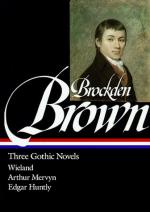|
This section contains 4,822 words (approx. 17 pages at 300 words per page) |

|
SOURCE: "Savages and Savagism: Brockden Brown's Dramatic Irony," in Studies in Romanticism, Vol. VI, No. 4, Summer, 1967, pp. 214-25.
In the following essay, Kimball examines Brown's use of the term "savage, " arguing that Brown uses the term ironically, not as a reflection of "New World experiences" with Indians, as many critics have contended, but as a way of commenting on the human capacity for violence.
Critics of Charles Brockden Brown's Edgar Huntly (1799) have taken the titular hero at his word. "My parents and an infant child were murdered in their beds," he says. Thus "I never looked upon or called up the image of a savage without shuddering."1 Accordingly, critics say that Huntly's attitude reflects New World experience with the red man, and that Brown considers the Indian a murderous savage "whose every action if not closely circumscribed leads to tragedy."2
This approach overlooks Brown's ironic use of the...
|
This section contains 4,822 words (approx. 17 pages at 300 words per page) |

|


